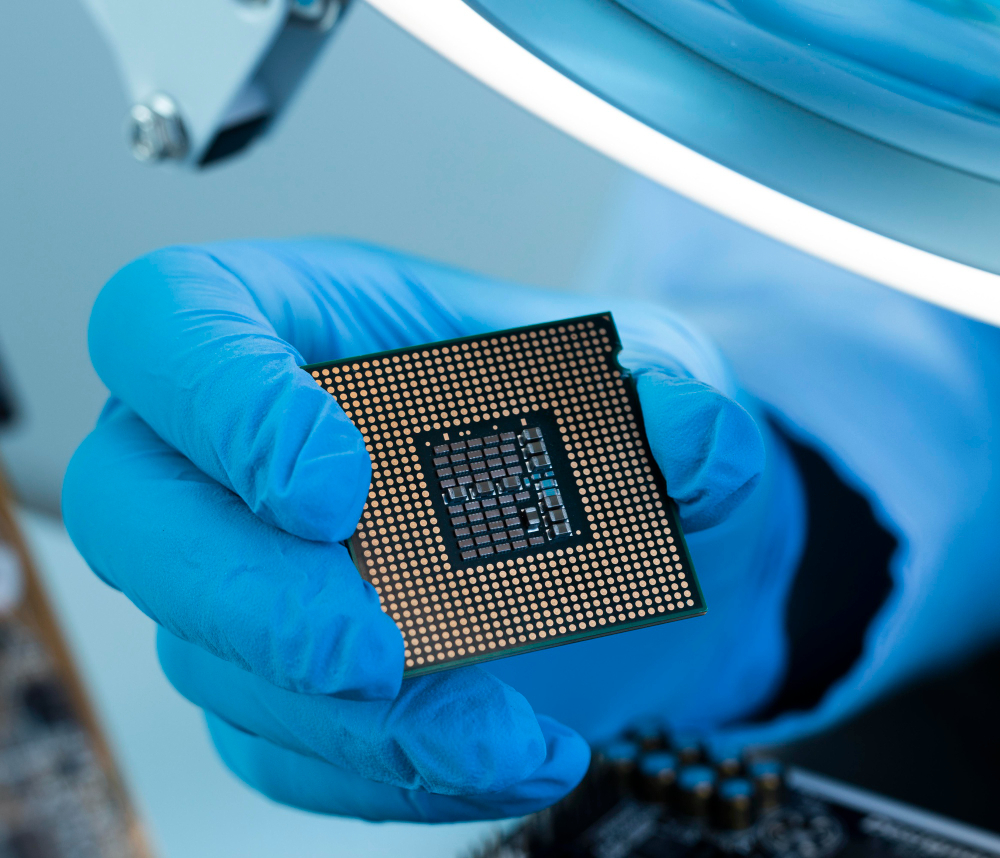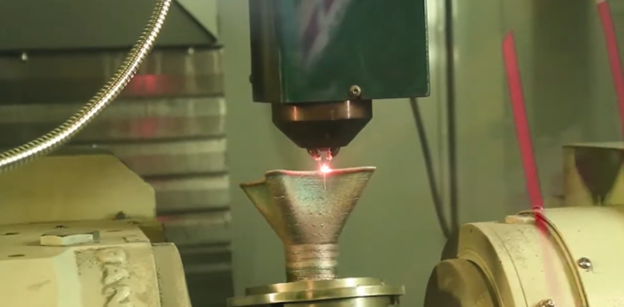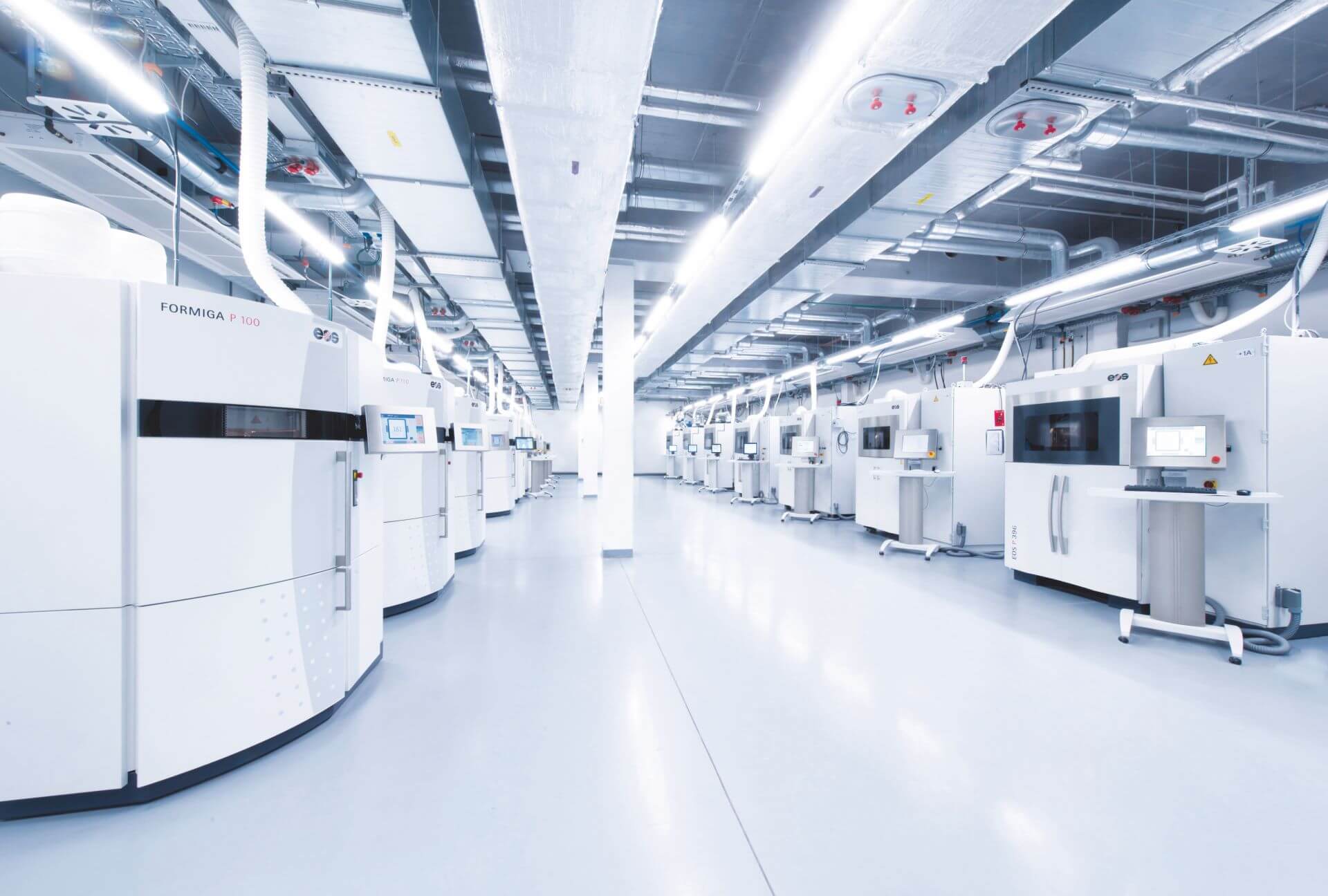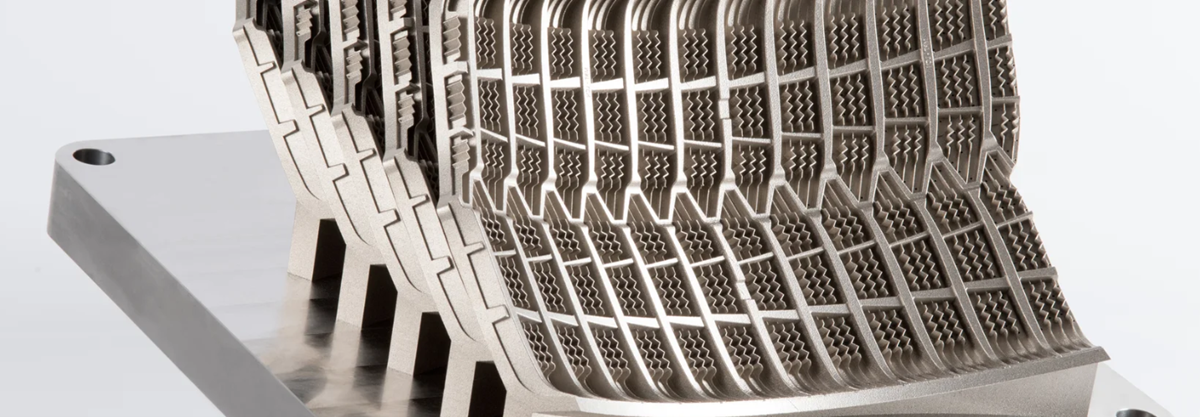Accelerate High-Power Electric Drive Design with Integrated Simulation
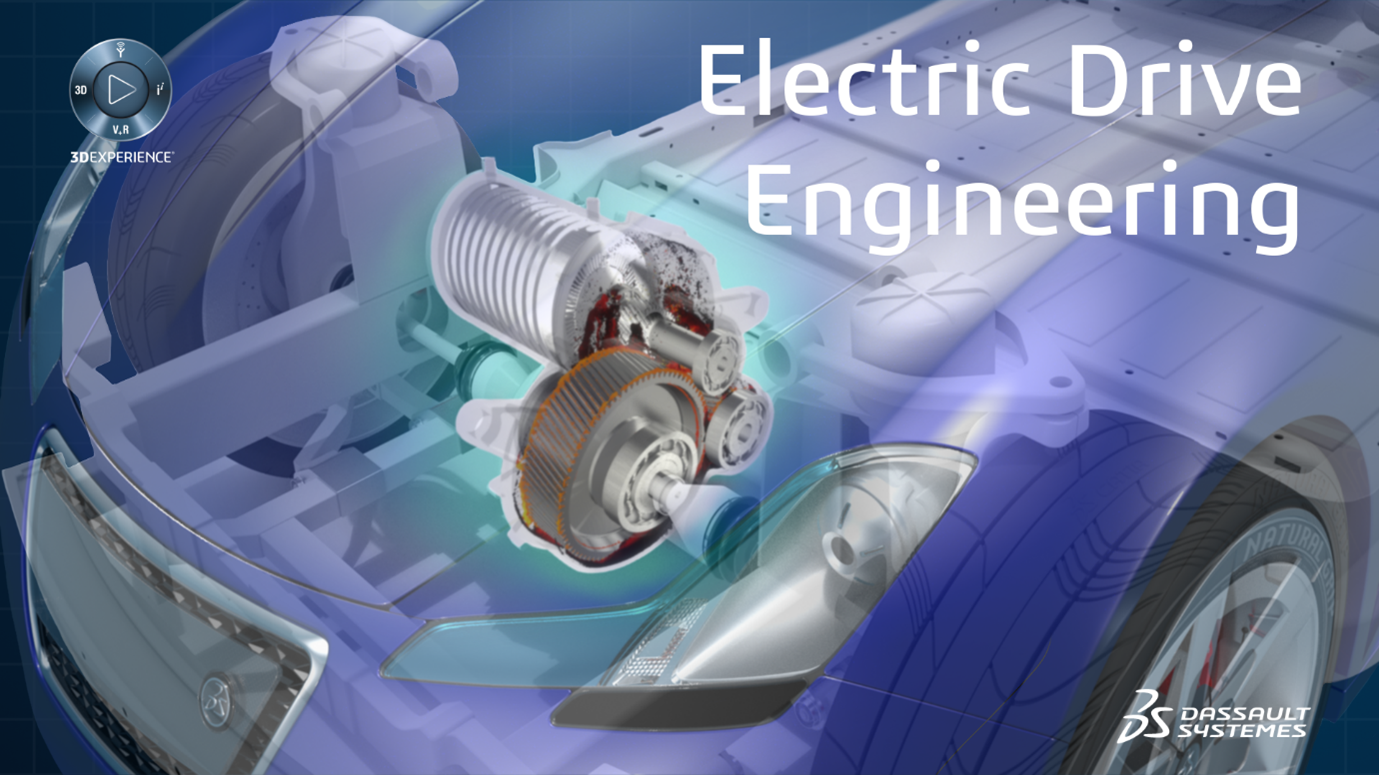
- Swapnil Deshmukh
- April 3, 2025
Industry Trends
- The strong trend towards vehicle electrification is driving the need and urgency for complete solutions for electric drive engineering. Numerous OEMs (both traditional OEMs and start-ups) and governing entities (e.g., France, London, California, China, India, etc.) have clearly indicated their strategic intent to move their states in the direction of vehicle electrification now and into the near future.
- Consumers expect equal or better performance from Battery Electric Vehicles versus Internal Combustion Engine vehicles, with all the added benefits of lower fuel costs and lower emissions.
- OEMs are recognizing the long-term strategic importance of having core competency in battery and electric drive engineering and are increasingly bring this work in-house rather than relying on suppliers.
- Electromagnetic performance is strongly affected by temperature, so thermal management of the electric drive is a key engineering factor, which in turn is requiring OEMs to completely overhaul their vehicle thermal management strategies.
- Consumers expect acceptable levels of noise and vibration in the cabin – this Noise & Vibration engineering challenge is exacerbated by the elimination of the internal combustion engine noise and vibration which has raised consumer awareness to electric motor noise
Engineering Objectives
The primary requirement of the electric drive unit is to deliver power in the form of mechanical torque which is directly dependent on its size. However, the size of the electric drive is constrained by form factor (available volume and mass). Hence the engineering objectives for an electric drive are:
Achieve market-required high power density while managing cost and supply chain risk: The motor design aims to minimize space while still delivering the highest possible power output. Use of rare-earth materials, which can typically help achieve this goal, are expensive and subject to supply chain risk.
- Optimize performance and efficiency across multiple disciplines: Electromagnetic performance must be balanced against thermal management, strength and durability, and noise and vibration attributes.
- Minimize risk of warranty claims & recalls.
- Manage occupant comfort (acoustic noise): Removal of traditional IC engine noise brings high frequency motor noises to the attention of vehicle occupants. This is a new challenge for automotive engineering.
Challenges
Describe the key challenges faced by most customers today in executing this process efficiently and effectively.
Electric Drive Engineering Challenges:
- Extreme packaging constraints
- Design and production cost constraints
- Difficult to predict and optimize complex discipline behaviors as well as the interactions across disciplines (electromagnetic performance, thermal, strength, durability, noise & vibration)
- Disconnected tools, organizations, and processes
- The electric drive is a sub-system of the larger, complex electric powertrain system. Its control system needs to be integrated within the overall vehicle control strategy.
- Maintaining electric machine air gap at high rpm ( as high as 30,000 rpm) and high centrifugal loads (air gap between stator and rotor)
- E-drive durability requires consideration of high rotational speeds and overall levels of vibration.
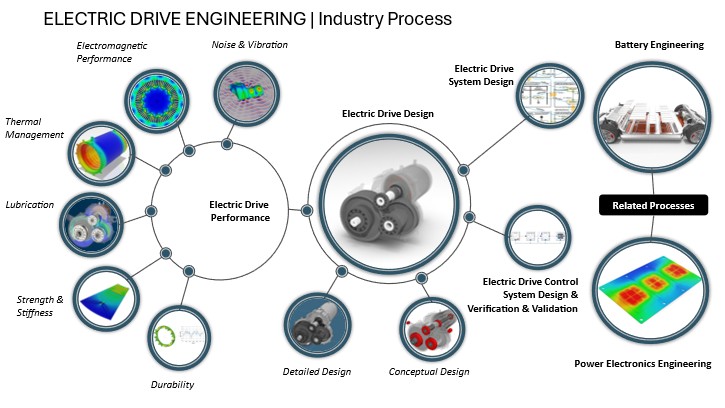
With the Electric Drive Engineering industry process, we can
- Optimize electric machine rotor and stator design using electromagnetic simulations to predict torque, flux, induced voltage and power, while minimizing losses and preventing demagnetization
- Perform multi-body dynamics and structural simulations given outputs from electromagnetic analysis to minimize vibration and ensure durable and quiet operation
- Execute thermal analysis to maintain operating temperatures across all performance conditions
- Minimize churning losses between oil and gears, while making sure contact surfaces are properly lubricated
Electric Drive Engineering following important characteristics
- Electric Machine
- Gearbox
- Structural Housing
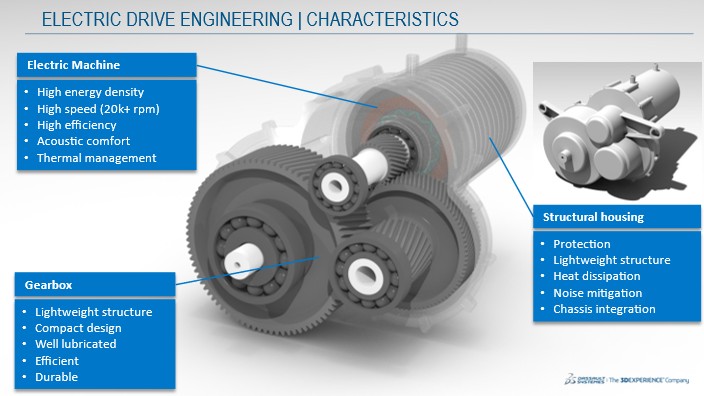
Benefits
Electric Drive Engineering Industry Process Experience Benefits:
- Development time & cost reduced by as much as 1/3
- Simulation activities tightly integrated with Design (CAD)
- Integration of multi-disciplinary tools enables more efficient trade-off analysis
- Ease of use enables democratization of engineering activities across designers and domain experts
- Accurate prediction of multidisciplinary KPIs and opportunity for multidisciplinary design optimization
- Best in class individual disciplinary tools (electromagnetic performance, thermal management, strength and durability, noise and vibration)
- Integration of multiple disciplines enabling trade-off studies and multidisciplinary optimization
- True systems engineering approach to minimize complexity and ensure compliance with requirements
- This Industry Process Experience incorporates Model Based Systems Engineering methodologies and tools on the 3DEXPERIENCE Platform
- Reduced risk of warranty and recall
- Detailed validation and verification can be performed
- Consumer delight with performance, efficiency and comfort

- Swapnil Deshmukh
- April 3, 2025
Accelerate High-Power Electric Drive Design with Integrated Simulation
Industry Trends
- The strong trend towards vehicle electrification is driving the need and urgency for complete solutions for electric drive engineering. Numerous OEMs (both traditional OEMs and start-ups) and governing entities (e.g., France, London, California, China, India, etc.) have clearly indicated their strategic intent to move their states in the direction of vehicle electrification now and into the near future.
- Consumers expect equal or better performance from Battery Electric Vehicles versus Internal Combustion Engine vehicles, with all the added benefits of lower fuel costs and lower emissions.
- OEMs are recognizing the long-term strategic importance of having core competency in battery and electric drive engineering and are increasingly bring this work in-house rather than relying on suppliers.
- Electromagnetic performance is strongly affected by temperature, so thermal management of the electric drive is a key engineering factor, which in turn is requiring OEMs to completely overhaul their vehicle thermal management strategies.
- Consumers expect acceptable levels of noise and vibration in the cabin – this Noise & Vibration engineering challenge is exacerbated by the elimination of the internal combustion engine noise and vibration which has raised consumer awareness to electric motor noise
Engineering Objectives
The primary requirement of the electric drive unit is to deliver power in the form of mechanical torque which is directly dependent on its size. However, the size of the electric drive is constrained by form factor (available volume and mass). Hence the engineering objectives for an electric drive are:
Achieve market-required high power density while managing cost and supply chain risk: The motor design aims to minimize space while still delivering the highest possible power output. Use of rare-earth materials, which can typically help achieve this goal, are expensive and subject to supply chain risk.
- Optimize performance and efficiency across multiple disciplines: Electromagnetic performance must be balanced against thermal management, strength and durability, and noise and vibration attributes.
- Minimize risk of warranty claims & recalls.
- Manage occupant comfort (acoustic noise): Removal of traditional IC engine noise brings high frequency motor noises to the attention of vehicle occupants. This is a new challenge for automotive engineering.
Challenges
Describe the key challenges faced by most customers today in executing this process efficiently and effectively.
Electric Drive Engineering Challenges:
- Extreme packaging constraints
- Design and production cost constraints
- Difficult to predict and optimize complex discipline behaviors as well as the interactions across disciplines (electromagnetic performance, thermal, strength, durability, noise & vibration)
- Disconnected tools, organizations, and processes
- The electric drive is a sub-system of the larger, complex electric powertrain system. Its control system needs to be integrated within the overall vehicle control strategy.
- Maintaining electric machine air gap at high rpm ( as high as 30,000 rpm) and high centrifugal loads (air gap between stator and rotor)
- E-drive durability requires consideration of high rotational speeds and overall levels of vibration.

With the Electric Drive Engineering industry process, we can
- Optimize electric machine rotor and stator design using electromagnetic simulations to predict torque, flux, induced voltage and power, while minimizing losses and preventing demagnetization
- Perform multi-body dynamics and structural simulations given outputs from electromagnetic analysis to minimize vibration and ensure durable and quiet operation
- Execute thermal analysis to maintain operating temperatures across all performance conditions
- Minimize churning losses between oil and gears, while making sure contact surfaces are properly lubricated
Electric Drive Engineering following important characteristics
- Electric Machine
- Gearbox
- Structural Housing

Benefits
Electric Drive Engineering Industry Process Experience Benefits:
- Development time & cost reduced by as much as 1/3
- Simulation activities tightly integrated with Design (CAD)
- Integration of multi-disciplinary tools enables more efficient trade-off analysis
- Ease of use enables democratization of engineering activities across designers and domain experts
- Accurate prediction of multidisciplinary KPIs and opportunity for multidisciplinary design optimization
- Best in class individual disciplinary tools (electromagnetic performance, thermal management, strength and durability, noise and vibration)
- Integration of multiple disciplines enabling trade-off studies and multidisciplinary optimization
- True systems engineering approach to minimize complexity and ensure compliance with requirements
- This Industry Process Experience incorporates Model Based Systems Engineering methodologies and tools on the 3DEXPERIENCE Platform
- Reduced risk of warranty and recall
- Detailed validation and verification can be performed
- Consumer delight with performance, efficiency and comfort

